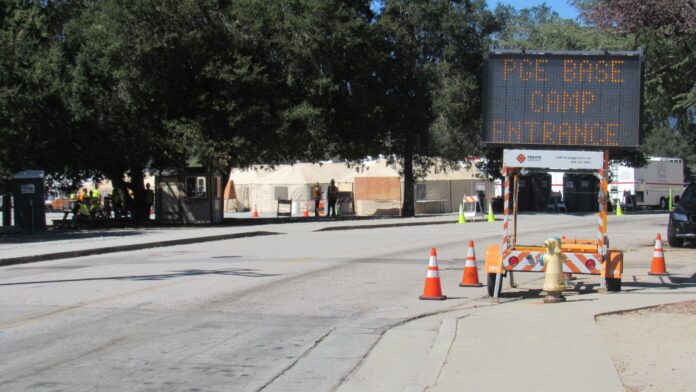Many local residents have by now noticed the recent “base camp” for the Pacific Gas and Electric Company (PG&E) that suddenly appeared on the former Sky Park Airport early last week. The “base camp” is in response to the recent and dramatically increasing wildfire threat, according to PG&E. The “base camp” looks like a military outpost with temporary canvas buildings, klieg lights and a huge fleet of Davey Tree trucks. The press release sent out by PG&E explains, “Vegetation work is expected to take place between now and the end of the 2018 wildfire season.
This “base camp” for coordinating tree cutting trucks and equipment has alarmed environmentalists in the Valley. According to Nancy Macy, chair of the Environmental Committee of the Valley Women’s Club, this has “terrified the community- what plan is PG&E is working from? Why doesn’t the public know anything about it? What are the impacts to the environment, especially in terms of hillside erosion and future mudslides, of cutting down large swaths of trees? What environmental clearance does PG&E have to cut down our trees?”
“PG&E is not adequately informing residents of their right to refuse to allow the removal or cutting of vegetation. PG&E is not a regulatory agency and their decisions do not carry the force of law,” Macy wrote in a lengthy email to county supervisors dated Sept. 14. That email also thanked 5th District Supervisor Bruce McPherson for his efforts “to keep PG&E from decimating the roadsides of the Santa Cruz Mountains.”
Mayra Tostado, PG&E Spokesperson, said the “base camp” is part of an “accelerated vegetation management program” to insure greater clearances between trees and power lines in response to “extreme fire danger” throughout Santa Cruz County. New safety standards, referred to as the Community Wildfire Safety Program, require “clearances of 12 feet or more between power lines and trees at the time of trim to ensure compliance year-round,” according to PG&E.
Several residents of the San Lorenzo Valley are pushing on the County board of supervisors to enforce local tree ordinances and require encroachment permits- arguing the environmental damage caused by cutting down trees is a bigger threat, particularly in the mountains, than wildfires.
According to Kevin Collins, a resident of Lompico canyon and a member of the Valley Women’s Club Environmental Committee, this is especially egregious because there is a proven technological alternative to the 12-foot tree clearance around electric lines that will actually prevent broken electric lines from starting wildfires.
According to Collins, the use of micro-processing technology that works like a lightning fast circuit breaker can cut the power to a broken electric line before it hits the ground if it gets broken by a falling tree or tree limb. These devices, called “high impedance arc fault interruptors” are getting implemented by other electric power utility companies, but PG&E apparently refuses to invest in this technology in favor clearing trees, Collins explained.
Collins filed a formal, 13-page complaint with the California Public Utilities Commission (CPUC), the agency authorizing PG&E’s Community Wildfire Safety Program, on Aug. 10. The complaint claims, “No sensible person would dispute that tree branches and falling trees are a problem for overhead power wire. But the plan that PG&E has made public will change wildfire behavior for the worse by opening and expanding wind corridors that enhance wildfire spread and fire intensity,” Collins wrote in his complaint.
Collins is convinced the destruction of trees does not address the ignition of wildfires that a broken “flash arching live wire” can cause when it touches ground. In fact, as explained in his complaint to the CPUC, “PG&E’s plan focuses upon vegetation management rather than upon the root causes of the fire ignitions caused by their own distribution equipment. Their plan is destructive, misleading and will fail to solve the problem of electric utility caused fires.”
“It’s not only that I don’t want my rural road mangled,” Collins said. “This has huge environmental impacts over a vast part of California-with no environmental review. PG&E is incredibly powerful,” Collins added. Powerful enough to ignore a demand from Santa Cruz County back in March for environmental review and encroachment permits to cut down heritage trees for the Community Pipeline Safety Initiative, Collins explained. In terms of compliance with the California Environmental Quality Act (CEQA), Collins contends that, incredibly and probably illegally, the CPUC determined the Community Wildfire Safety Program did not constitute “a project” under CEQA, and therefore no environmental review is required.
An email from Supervisor McPherson’s office stated the following, “PG&E can and is approaching private property owners about removing or trimming trees on private property. Private property owners have the ability to negotiate with PG&E about work being done on their property, and we have received assurances that PG&E will not threaten property owners with shutting off their power if they decline to allow PG&E to do vegetation work.”
Vegetation removal in the public right of way is a different story. The County is requiring PG&E to obtain an encroachment permit to perform their work. While the permitting process is under way, the County continues to assert its environmental review authority over PG&E in the County right of way, and the Board of Supervisors is considering all of its options.”













